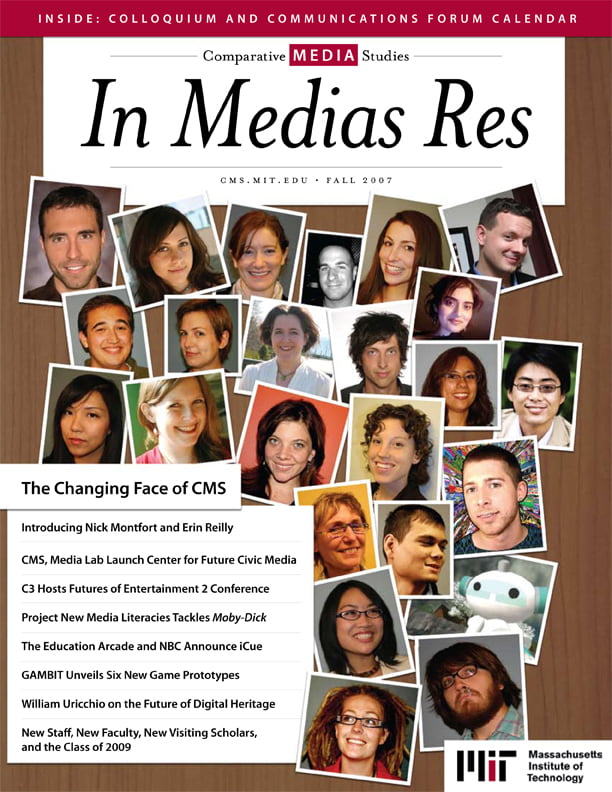

The new GAMBIT lab facility over at 5 Cambridge Center (two stories above Legal Sea Foods) opened mid-summer and has transformed how CMS operates. If you haven’t been over to GAMBIT yet, you should do so. The Lab space was created with support from the Singapore Media Development Authority and National Research Foundation and from MIT to help sustain a new center designed to do the kind of research and development that is not taking place within the games industry but which will stretch the medium in important new directions.
As you walk through the door, you will see an image of the screen of Spacewar! etched in glass. Here’s the back story: Spacewar! is believed to be the first interactive computer game, built in the early 1960s by the Tech Model Railroad Club, which was at the time housed in MIT’s legendary Building 20. The game deployed the Artificial Intelligence Lab’s PDP-1 computer. Soon, the game was widely deployed as a test whenever PDP-1 computers were installed. More importantly, it set the stage for subsequent experiments with computer and video games. Oddly enough, there is no plaque honoring the Tech Model Railroad Club for its place in video games history amongst the various memorials to Building 20 in the new Stata Center, so we’ve chosen to recognize it within CMS, one of a number of recent efforts to help our students recognize the fit between their current projects and a much larger history of media theory and production at MIT.
If you walked past the Spacewar! memorial this summer and into the heart of GAMBIT, you would have seen something truly remarkable: a team of 40 students from 9 different Singaporean institutions working hand in hand with undergraduate and graduate students from CMS and Computer Science to develop cutting-edge games. The projects they built were creatively interesting and technically challenging; they had compelling graphics and engaging soundtracks; and they were all developed through an eight-week rapid prototyping and development process which would put most professional game companies to shame. To visit the lab at that point, you would have found walls plastered with artist sketches, flowcharts, and development schedules, signs of a creative process at work. What these students did this summer has already attracted media attention in both the United States and Singapore; participants are scoring top level jobs in game companies around the world; and the projects themselves are being closely reviewed by game companies in the hopes that some of them will get picked up for commercial distribution.
With the start of the academic year, CMS has taken over much of the lab space to serve our own expanding pedagogical and research needs. (If you don’t think CMS is expanding, just look at all of the announcements of new staff and students in this issue!) Each of the CMS research initiatives now have designated spaces, which means that we have room for teams of students to work together on projects. The result has been a dramatic shift towards greater collaboration throughout the research process and a fuller integration of learning and research activities. It is also resulting in greater collaboration across the teams because people run into each other in the hallways at GAMBIT and start to talk about the work they are doing. Increasingly, we are using the GAMBIT space for teaching with several of our required graduate subjects being hosted there this term.
The space played important roles during our orientation for new students; it is the location for Friday afternoon game playing sessions designed to bring the community together and familiarize them with new developments in this area, as well as the location chosen to host a half-day series of faculty meetings to help redesign the requirements for our undergraduate major. These sessions brought together 25 members of our (sometimes loosely) affiliated faculty, who cut across almost every part of the HASS school and beyond. Those participating were: Alan Brody, Tommy DeFrantz, Jay Scheib, Ian Condry, Stefan Helmreich, Marty Marks, Philip Tan, William Uricchio, Sarah Brouillette, Noel Jackson, Wyn Kelley, Nick Montfort, Ute Meta Bauer, Glorianna Davenport, Kurt Fendt, Leila Kinney, and Jing Wang. Many of those who came ended up hanging out with students and research staff longer than expected and came away with a much better picture of what CMS is becoming. The Lab space will also host a growing number of post-docs and visiting scholars who are being better integrated into the research process and will bring valuable new perspectives to our ongoing discussions.
Other CMS activities remain scattered across multiple locations on campus (including, of course, our headquarters space in building 14) as we await completion of the new MIT Media complex where our core operations will unfold alongside those of the Media Lab, the Center for Advanced Visual Studies, and other media-related groups.
During the summer, the GAMBIT Lab is emblematic of the ways CMS translates humanistic insights into pragmatic projects and the ways our research is starting to have a global impact. During the academic year, GAMBIT is allowing CMS to reinvent itself, to better achieve our goals both inside the classroom and inside the research laboratory, to bring faculty, staff, and students together in new ways, and to create a context for collaborative work in the future.



